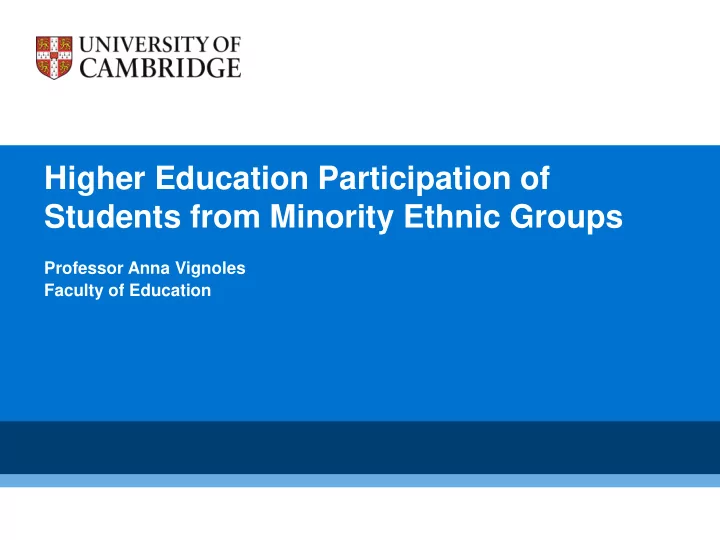

Higher Education Participation of Students from Minority Ethnic Groups Professor Anna Vignoles Faculty of Education
Key messages • Focus on young students progressing from school to HE rather than mature students • Students from minority ethnic groups are, on average, more likely to go to university than White British pupils • This is a significant change in recent years for some groups e.g. Black African students
Key messages • Black Caribbean and Other Black students are less likely to attend a “high status” institution than White British students • All other minority ethnic groups are more likely to attend a high status institution than White British • But comparing similarly qualified individuals at key stage 5, all minority ethnic groups are more likely to attend a high status institution than White British Source: Chowdry et al. 2013; Crawford and Greaves 2015 Note: High status defined either as Russell Group or equivalent in the Research Assessment Exercise or top third institution in terms of HESA tariff scores
Key messages • Ethnicity and socio-economic status are interlinked • Ethnic minority students are more likely to come from poorer households and this issue is at the root of low BME social mobility • Low socio-economic status is a very strong predictor of low achievement and low levels of HE participation - for all ethnic groups
Key messages • There remain inequalities in access at the top end of the income distribution • Among those from the richest fifth of households, Black Caribbean and Black Other students are less likely to attend HE than White British • Minority ethnic students from less advantaged backgrounds are more likely to attend HE than a comparable White British student Crawford and Greaves 2015
There remain serious issues of concern….. • Non continuation rates are higher for some BME groups • Some BME groups less likely to get a “good” degree or achieve a degree • Employment and earnings outcomes are weaker for some BME groups • Some BME groups less likely to go on to postgraduate study 6
What should policy focus upon? • Large socio-economic gaps in school achievement at GCSE and A level determine HE participation • And minority ethnic pupils are disproportionately represented in lower SES groups →Focus on low achievement of poorer children earlier in the school system →Focus on progression of BME students through HE and into the labour market
References • Chowdry, Haroon, Claire Crawford, Lorraine Dearden, Alissa Goodman, and Anna Vignoles. "Widening participation in higher education: analysis using linked administrative data." Journal of the Royal Statistical Society: Series A (Statistics in Society) 176, no. 2 (2013): 431-457. • Crawford , C. (2012). ‘Socio -economic gaps in HE participation: How have they changed over time?’ Institute for Fiscal Studies, Briefing Note BN133. • Department for Education (2015) GCSE and equivalent attainment by pupil characteristics: 2014, Statistical First Release. https://www.gov.uk/government/statistics/gcse-and- equivalent-attainment-by-pupil-characteristics-2014 • Goodman, Alissa, and Paul Gregg, eds. Poorer children's educational attainment: how important are attitudes and behaviour? . York: Joseph Rowntree Foundation, 2010.
Supporting Data • Data supporting previous points is set out below.
Achievement at GCSE • Minority ethnic group students are generally as high achieving or indeed higher achieving than White British at GCSE • Black Caribbean and Black other students have somewhat lower achievement at GCSE than White British • Very low achievement of students who are classified as traveller of Irish heritage or Gypsy/ Roma • Amongst FSM students, minority ethnic groups have higher achievement (bar traveller of Irish heritage/Gypsy Roma)
Achievement at GCSE by ethnic group 2013/14 Percentage achieving 5+ A*-C grades 90 80 70 60 50 % 40 30 20 10 0 FSM All Source: Department for Education (2015)
Gaps in HE participation • Chowdry et al. 2013 data from cohorts who sat GCSE examinations at age 16 in 2001 – 02/ 2002-03 • Taking account of differences in academic achievement at GCSE/ A level: – minority ethnic group students are even more likely to participate in HE – many minority ethnic groups are more likely to participate in high status institutions than White British (though students classified as Other Black are less likely) Chowdry et al. 2013
Percentage point gaps in participation rates, after allowing for achievement at GCSE and A level HE participation High status HE participation 18 6 Ppt difference in HE participation Ppt difference in HE participation 16 5 14 4 12 3 10 8 2 Males Males 6 Females Females 1 4 0 2 -1 0 -2 -3 Chowdry, Crawford, Dearden, Goodman and Vignoles (2013). Cohorts who sat GCSE examinations at age 16 in 2001 – 02/ 2002-03 High status – Russell Group institution or equivalent in RAE
HE participation by ethnic group and socio-economic status, 2010-12 HE participation rate Source: Crawford and Greaves, 2015, Institute for Fiscal Studies, http://www.ifs.org.uk/publications/8042. Cohort who sat their GCSEs in 2008
Minority ethnic students are disproportionately likely to come from lower income groups 2nd Lowest 2nd lowest 3nd lowest highest Highest SES group SES group SES group SES group SES group White British 18.41 19.12 19.9 20.95 21.62 100 Other White 18.51 19.67 20.67 19.56 21.59 100 Black African 40.24 25.42 19.01 10.51 4.82 100 Black Caribbean 32.45 23.58 23.4 14.74 5.83 100 Other Black 34.39 23.43 20.92 13.92 7.34 100 Indian 11.52 24.9 26.27 20.99 16.32 100 Pakistani 34.56 32.28 17.09 9.76 6.3 100 Bangladeshi 51.5 24.56 13.53 6.86 3.55 100 Chinese 19.36 16.59 19.09 21.65 23.32 100 Other Asian 17.85 23.22 25.72 20.33 12.88 100 Mixed 25.24 21.22 19.43 17.52 16.58 100 Other 30.38 22.74 19.59 15.83 11.46 100 Source: Crawford and Greaves, 2015, Institute for Fiscal Studies, http://www.ifs.org.uk/publications/8042. Cohort who sat their GCSEs in 2008
Recommend
More recommend